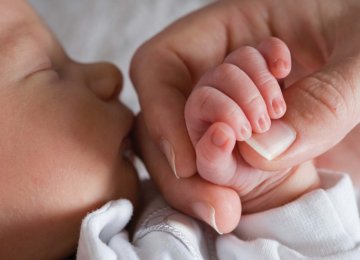Iranian couples no longer need to travel abroad for consultation or treatment for infertility as advanced methods of treatment for couples who have problems to conceive, are available in the country, said Dr Seyed Jalil Hosseini, head of the Infertility and Reproductive Health Research Center at Tehran’s Shahid Beheshti University of Medical Sciences (SBUMS).
“Infertility affects an estimated 10%-15% of couples globally,” IRNA quoted him as saying.
There are 3 million infertile couples in the country. Around 3-4% of young Iranian women suffer from recurrent miscarriages. Infertility rate is about 2.5% and secondary infertility is more prevalent than primary infertility. When a woman is not able to conceive at all, (due to infertility in either spouse), it is referred to as primary fertility. Secondary infertility is when a woman is unable to conceive again after the first successful pregnancy and childbirth. While causes of secondary infertility vary, the most important risk factors are advanced reproductive age, weight gain, abdominal surgeries, sperm quality and quantity and smoking.
The 9th congress on the latest methods of infertility treatment will be held on November 16-18 at the International Conference Center at SBUMS, Hosseini said.
“Microsurgical reconstruction for male infertility, new methods of male infertility treatment (medication, surgery, and Intracytoplasmic Sperm Injection (ICSI)), role of complementary therapies and medicines to improve fertility, and new imaging techniques for assessment of infertility problems in both genders, are among the main important topics that will be discussed.”
“At present, there are 60 infertility centers across the country and 20 more will be launched by the end of the current year in March 2017, he said.
Additionally, 35 state-run universities of medical sciences will be equipped with new laboratory equipment and devices for identification and treatment of infertility problems, he added.
IVF Hope for Childless Couples
Since April 2015, an infertility treatment plan called ‘Barekat-e-Khanevadeh’ (Family Blessing) is underway in Iran’s underprivileged areas in 10 provinces and all infertile couples between the ages 20-40 years can benefit from the specialized treatments, free of charge.
“The plan will be continued in the current year as well,” said Seyed Ebadollah Emadi, program manager in an interview with ‘Mehrkhane,’ a news and analysis website on women.
“Based on the latest surveys conducted, it is estimated that there are 450,000 infertile couples in the rural areas and some of them cannot afford to pay for the costly infertility treatments,” he said.
So far, more than 2,800 infertile couples in the country have been identified of whom 1,100 have undergone treatment for infertility.
Ebadi said cooperation agreements with 10 hospitals across the country had been signed and infertile couples who cannot afford the treatment are recommended to the hospitals.”
Stating that since the beginning of the project implementation, 250 free IVF has been performed for poor childless couples across the country, he said, “However, the problems of some couples can be simply resolved by medications.”
“IVF is never the first step in the treatment of infertility. Instead, it’s reserved for cases in which other methods such as fertility drugs, surgery, and artificial insemination haven’t worked.”
On average, an IVF cycle costs $2,300-$2,900 in the country, while the majority of women have per-cycle success rates of 20-35%, which means they often need multiple tries to get pregnant.
IVF may be an option if one of the spouses or both have been diagnosed with problems like endometriosis, low sperm count, problems with ovulation, antibody problems that harm sperms or eggs, and unexplained fertility problems.
TFR Below Global Average
The infertility treatment program conducted jointly by the Health Ministry and the Barekat Foundation (affiliated to Setad which is a special office for executing the decrees of Imam Khomeini in helping the underprivileged) is in line with the general population policies to enhance population growth set by the Leader, Ayatollah Seyyed Ali Khamenei in June 2014.
At current fertility rates, Iran’s median age is expected to increase from 28 in 2013 to 40 by 2030. The possibility of zero population growth rate by the year 2050 cannot be ruled out.
The total fertility rate (TFR) or the average number of children born to a woman in her lifetime, is currently 1.8 in Iran which is the lowest among Islamic countries, and even below the world average of 2.1 births per woman.





